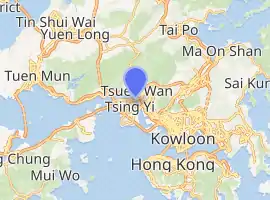Tsing Yi North Bridge
Tsing Yi North Bridge (Chinese: 青衣北橋), also called Tsing Tsuen Bridge (青荃橋), connects the Tam Kon Shan Interchange on Tsing Yi Island to the Texaco Road Roundabout in Tsuen Wan, spanning the Rambler Channel. Inaugurated on 10 December 1987, the bridge was designed to improve access to Tsing Yi, which at that time was connected to Kwai Chung by only one fixed link, the heavily congested Tsing Yi Bridge.
Tsing Yi North Bridge | |
|---|---|
 View from south | |
| Coordinates | 22°21′36″N 114°6′37″E |
| Carries | Motor vehicles, pedestrians |
| Crosses | Rambler Channel |
| Locale | Kwai Tsing District Hong Kong |
| Owner | Hong Kong Government |
| Maintained by | Highways Department |
| Characteristics | |
| Total length | 1,015 metres[1] |
| Longest span | 160 metres[2] |
| Piers in water | 2 |
| History | |
| Designer | Scott Wilson Kirkpatrick and Partners |
| Constructed by | Maeda/Oriental Joint Venture |
| Construction start | 24 September 1984[1] |
| Construction cost | HK$200 million[3] |
| Opened | 11 December 1987[4] |
| Inaugurated | 10 December 1987[3] |
| Statistics | |
| Daily traffic | 41,680 (2016)[5] |
| Location | |

| |
History
The Tsing Yi North Bridge was intended to alleviate congestion on Tsing Yi's sole existing bridge to the south. It was designed by Scott Wilson Kirkpatrick and Partners and constructed by the Maeda/Oriental Joint Venture.[6] Construction began on 24 September 1984.[1]
An opening ceremony for the Tsing Yi North Bridge, built at a cost of HK$200 million, was held by Governor David Wilson on 10 December 1987.[3] It opened to traffic on 11 December 1987, at which time it was the longest bridge in Hong Kong.[4]
The ferry service between Tsing Yi and Tsuen Wan was terminated by Hongkong and Yaumati Ferry several years after the opening of the North Bridge.
Structure
Tsing Yi North Bridge was, when opened in 1987, Hong Kong's largest prestressed balanced cantilever bridge with a main navigation span of 160 metres, side spans of 90 metres, and approach viaducts that brought the total length to 1,015 metres.[2] The design can support a 2-way and 4-lane traffic. The balustrade on the bridge was an aluminium-type to prevent rusting, although it was changed to welded stainless steel, because of the frequent stolen cases of aluminium bars in the past decades.
Extension
On 1 February 2002, the day of the opening of Tsing Yi North Coastal Road, the North Bridge was connected and became the main path from Tsuen Wan to Tung Chung on Lantau Island and the International Airport in Chek Lap Kok.
Transportation
Pavements are available on both side of the bridge.
The following are Kowloon Motor Bus bus routes via the bridge:
- 41 Cheung Ching - Kowloon City Ferry
- 41M Tsing Yi Estate - Tsuen Wan MTR Station
- 41P Tsing Yi Ferry - Tsuen Wan MTR Station (weekday and peak time service only)
- 42C Cheung Hang - Lam Tin MTR Station
- 42M Cheung Wang - Tsuen Wan (Discovery Park)
- 43B Cheung Ching - Tsuen Wan West station
- 44 Tsing Yi Estate - Mong Kok East Railway Station
- 49P Sha Tin Central - Tsing Yi Ferry (Weekday and Peak Time Service Only)
- 49X Tsing Yi Ferry - Kwong Yuen
- 68A Tsing Yi AR Station - Long Ping Estate
- 243M Mayfair Gardens - Tsuen Wan (Discovery Park)
- X42P Cheung On - Lam Tin MTR Station (weekday and peak time service only)
References
- McKenna, B.R.; Palmer, G. (June 1989). "Tsing Yi North Bridge: construction". Proceedings of the Institution of Civil Engineers. 86 (3): 491–511.
- Denton-Cox, R.A.; Weir, K.L. (June 1989). "Tsing Yi North Bridge: planning and design". Proceedings of the Institution of Civil Engineers. 86 (3): 471–489.
- Wong, Brian (11 December 1987). "Government to look again at Tsing Yi plans". South China Morning Post. p. 6.
- "New Tsing Yi bridge fails to divert traffic". South China Morning Post. 17 December 1987. p. 2.
- "The Annual Traffic Census 2016" (PDF). Transport Department. August 2017.
- "Links to Tsing Yi". South China Morning Post. 12 September 1984. p. 17.
| Wikimedia Commons has media related to Tsing Yi North Bridge. |